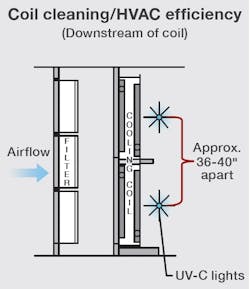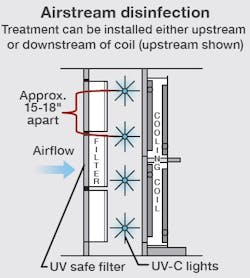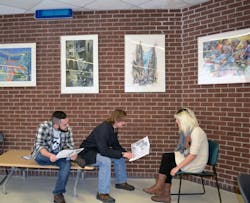Germicidal UV Demand Leaps from Niche to Necessity
By DANIEL JONES, UV Resources, Santa Clarita CA
As the SARS-CoV-2 virus evolved into a worldwide pandemic, ultraviolet germicidal irradiation (UGVI) or light in the 253.7 nm UV-C wavelength has become a "go-to" technology in the battle against the spread of COVID-19.
In early October 2020, the U.S. Centers for Disease Control and Prevention (CDC) confirmed what many researchers had believed for months[1]—that the coronavirus can be transmitted through the air and may be able to infect people who are more than six feet apart.[2]
- To read our June 2020 cover story, "Rays of Hope", click here.
Eighty-three years later, researchers believe the SARS-CoV-2 virus to be highly susceptible to germicidal UV-C irradiation.[4],[5] The CDC[6] and ASHRAE have recommended UV-C as one technology that can “reduce the risk of dissemination of infectious aerosols in buildings and transportation environments.”[7]
It’s important to note that science has not found any microorganism that can withstand the destructive effects of the UV-C germicidal wavelength, including superbugs and other antibiotic-resistant germs. In fact, viruses and bacteria cannot develop a resistance to germicidal UV because it uses energy to kill, rather than synthetic or chemical elements. And, unlike highly efficient particle filtration, UVGI does not impose a pressure drop burden on the ventilation system.
ASHRAE POSITION
At present, ASHRAE does not have an official policy or recommendation on the use of ultraviolet light in air systems for microbial control. However, in its Position Document on Infectious Aerosols, ASHRAE does identify dilution and extraction ventilation, mechanical filtration and germicidal UV-C energy as effective strategies to reduce the spread of infectious aerosols.
Moreover, ASHRAE has recognized that the UV-C wavelength inactivates virtually all microorganisms living on HVACR surfaces, with kill ratios of up to 99 percent, depending on the intensity of the UV-C and the length of exposure.[8]PANDEMIC’S IMPACT ON UV-C MARKET
Prior to COVID-19, the UV-C market in the United States had seen continued growth, largely based on the germicidal wavelength’s ability to clean fouled cooling coils and improve HVAC energy efficiency, as well as to reduce maintenance. Since the pandemic struck, the application of UV-C has seen sudden, record-breaking growth and has become one of the most in-demand technologies around the world.
Almost overnight, UV-C systems have transformed from an HVAC accessory to a health and safety necessity.
As a result, UV lamp manufacturers, as well as their component suppliers (e.g. glass suppliers), have struggled to scale from what was a niche marketplace to mass production capable of meeting historic demand levels. Compounding these already strained supply chains, worldwide lockdowns shuttered many of the very manufacturers needed to boost UV component production.
SCARCE SUPPLY
The global UV disinfection equipment market generated $1.3 billion in 2019, and is estimated to reach $5.7 billion by 2027—a compounded annual growth rate of 17 percent—according to a report published by Allied Market Research.[9]
Because of UV-C’s historic proven effectiveness, interest and orders for UV disinfection equipment has increased exponentially during the COVID-19 pandemic. For example, in July, lighting manufacturer Signify (previously Philips Lighting), reported increasing “UV-C light source production capacity by a factor of eight.”[10]
This sudden and skyrocketing demand for surface disinfection and air treatment solutions, has spiked across all market sectors, including orders from traditional, commercial sectors such as hospitals, offices and hotels and restaurants.
Since March, many manufacturers have reported month-over-month increases in sales inquiries and shipments—exhausting planned “annual” inventories in a single month. The fact that demand is outpacing supply has created significant backorders due to insufficient raw material and component supplies.
The UV-C lamp supply in particular has suffered from a shortage in materials such as quartz glass pellets and glass frames, as well as furnace space to work the glass. Contractors would be well advised to place orders as early as possible and to accept partial-order shipments. This will ensure that HVAC firms have the components/fixtures in-house (or even installed) once the lamps finally arrive.
FUTURE DEMAND
According to Eric Rondolat, CEO of Signify (previously Philips Lighting), they have made a “significant investment for an increase in the requisitioned supply of components and additional furnace space for glass.”
Rondolat’s company is forecasting a three to four-fold increase in orders during 2021 over 2019 (pre-pandemic). Relative to the supply chain, in late July, Rondolat advised that he “expects to be back to significantly shorter lead times than at present in Q4 and into 2021.”
However, mechanical engineers and HVAC contractors should expect continued delays in UV-C lamps and components as it will take time for any supply increases to work their way through the channels.
As there is no clear end in sight for the COVID-19 pandemic; similarly, there is no foreseeable decline in the demand for the germ-killing and disinfection benefits offered by UV-C. In other words, we expect commercial and residential demand for UV solutions to remain high as perception for the technology has shifted from a want (HVAC Efficiency) to a need (health and safety).
Specifiers and HVAC contractors should not be deterred from recommending the proven benefits of UV-C disinfection systems, as the industry is rapidly adapting to what might likely be our “new normal” level of demand.
A TECHNOLOGY FOR THE TIMES
Despite nearly eight decades of research and thousands of applications in hospital emergency and operating rooms, urgent-care centers, universities, and first-responder locations, UV-C has not been widely leveraged.
The current pandemic, however, has laid bare the incalculable societal health outcomes offered by the proven germ-killing technology. All bacteria and viruses tested to date (many hundreds over the years, including other coronaviruses) are helpless against UV disinfection at the appropriate doses.[11]
Facility managers and mechanical engineers in some regions will find UV-C solutions even more affordable through federal subsidies designed to offset the cost of incorporating infection control measures. The Tennessee Valley Authority is offering a $30 per cooling ton subsidy that will cover about a third of the installed cost of a UV-C airstream disinfection system.[12} Incentives such as these will make this transformational and life-saving technology, even more attractive.
########
The author is president and co-founder of UV Resources, which he started in 2005. He serves on both ASHRAE Technical Committee 2.9 and ASHRAE SPC-185.2, devoted to Ultraviolet Air and Surface Treatment. He may be reached at [email protected].
########
[1] Morawska, L., & Cao, J. (2020). Airborne transmission of SARS-CoV-2: The world should face the reality. Environment International, 139. Retrieved from https://www.sciencedirect.com/science/article/pii/S016041202031254X?via%3Dihub
[2] Centers for Disease Control and Prevention (2020) Scientific Brief: SARS-CoV-2 and Potential Airborne Transmission: Scientific brief, 5 October 2020. Retreived from https://www.cdc.gov/coronavirus/2019-ncov/more/scientific-brief-sars-cov-2.html
[3] Wells WF, Wells MW, Wilder TS. The environmental control of epidemic contagion I: an epidemiologic study of radiant disinfection of air in day schools. American Journal of Hygiene, 35(1), 97-121; Retrieved from https://doi.org/10.1093/oxfordjournals.aje.a118789
[4] Heilingloh CS, Aufderhorst UW, Schipper L, et al. Susceptibility of SARS-CoV-2 to UV irradiation. Am J Infect Control, vol 48 issue 10. Pages 1273-1275. October 2020. Retrieved from https://www.sciencedirect.com/science/article/pii/S0196655320307562
[5] Illuminating Engineering Society (April 15, 2020) IES Committee Report:Germicidal Ultraviolet (GUV) – Frequently Asked Questions. IES CR-2-20-V1 Retrieved from
https://media.ies.org/docs/standards/IES-CR-2-20-V1-6d.pdf
[6] CDC. COVID-19 Employer Information for Office Buildings (September 11, 2020). Retrieved from https://www.cdc.gov/coronavirus/2019-ncov/community/office-buildings.html
[7] ASHRAE Position Document on Infectious Aerosols (April 14, 2020). Retrieved from https://www.ashrae.org/file%20library/about/position%20documents/pd_infectiousaerosols_2020.pdf
[8] ASHRAE. Position Document on Filtration and Air Cleaning. (2015). Retrieved from https://www.ashrae.org/File%20Library/About/Position%20Documents/Filtration-and-Air-Cleaning-PD.PDF#
[9] Allied Market Research (2020) Global UV Disinfection Equipment Market Opportunities and Industry Forecast, 2020–2027. Retrieved from
https://www.globenewswire.com/news-release/2020/08/06/2074364/0/en/Ultraviolet-UV-Disinfection-Equipment-Market-to-Reach-5-7-Billion-by-2027-Allied-Market-Research.html
[10] Signify second quarter results (2020). Retrieved from
https://www.signify.com/en-us/our-company/news/press-releases/2020/20200724-signify-second-quarter-results-2020
[11] International Ultraviolet Association. (2020) IUVA Fact Sheet on UV Disinfection for COVID-19. Retrieved from http://www.iuva.org/COVID-19
[12] Tennessee Valley Authority Press Release. (July 8, 2020) TVA Offers Incentives for Virus-Killing UV Technology. Retrieved from https://www.tva.com/newsroom/press-releases/tva-offers-incentives-for-virus-killing-uv-technology#:







